
A spruce is a tree of the genus Picea, a genus of about 40 species of coniferous evergreen trees in the family Pinaceae, found in the northern temperate and boreal (taiga) regions of the Earth. Picea is the sole genus in the subfamily Piceoideae. Spruces are large trees, from about 20 to 60 m tall when mature, and have whorled branches and conical form.

Lagerstroemia, commonly known as crape myrtle, is a genus of around 50 species of deciduous and evergreen trees and shrubs native to the Indian subcontinent, southeast Asia, northern Australia, and other parts of Oceania, cultivated in warmer climates around the world. It is a member of the family Lythraceae, which is also known as the loosestrife family. These flowering trees are beautifully colored and are often planted both privately and commercially as ornamentals.

Pinus albicaulis, known by the common names whitebark pine, white bark pine, white pine, pitch pine, scrub pine, and creeping pine, is a conifer tree native to the mountains of the western United States and Canada, specifically subalpine areas of the Sierra Nevada, Cascade Range, Pacific Coast Ranges, and Rocky Mountains. It shares the common name "creeping pine" with several other plants.

Chamaecyparis thyoides, a species of Cupressaceae, is native to the Atlantic coast of North America and is found from southern Maine to Georgia and along the Gulf of Mexico coast from Florida to Mississippi. It is one of two species of Chamaecyparis found in North America. C. thyoides resides on the East Coast and C. lawsoniana can be found on the West Coast. There are two geographically isolated subspecies, treated by some botanists as distinct species, by others at just varietal rank: Chamaecyparis thyoides thyoides and Chamaecyparis thyoides henryae (H.L.Li) E.Murray The species grows in forested wetlands where they tend to dominate the canopy. The trees are associated with a wide variety of other wetland species because of their wide north-south range. The remaining populations are now found mostly in remote locations that would be difficult to harvest, so its popularity as a source of lumber has decreased.
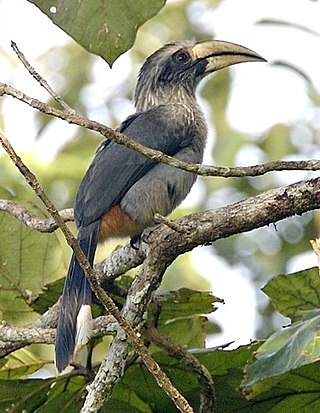
The Malabar gray hornbill is a hornbill endemic to the Western Ghats and associated hills of southern India. They have a large beak but lack the casque that is prominent in some other hornbill species. They are found mainly in dense forest and around rubber, arecanut or coffee plantations. They move around in pairs or small groups, feeding on figs and other forest fruits. Their loud cackling and laughing call makes them familiar to people living in the region.
Silviculture is the practice of controlling the growth, composition/structure, as well as quality of forests to meet values and needs, specifically timber production.

The Malabar Coast moist forests are a tropical moist broadleaf forest ecoregion of southwestern India.

Taxodium distichum is a deciduous conifer in the family Cupressaceae. It is native to the southeastern United States. Hardy and tough, this tree adapts to a wide range of soil types, whether wet, salty, dry, or swampy. It is noted for the russet-red fall color of its lacy needles.
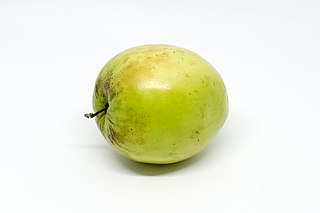
Ziziphus mauritiana, also known as Indian jujube, Indian plum, Chinese date, Chinee apple, ber and dunks is a tropical fruit tree species belonging to the family Rhamnaceae. It is often confused with the closely related Chinese jujube, but whereas Z. jujuba prefers temperate climates, Z. mauritiana is tropical to subtropical.

Parkinsonia microphylla, the yellow paloverde, foothill paloverde or little-leaved palo verde; syn. Cercidium microphyllum), is a species of palo verde.

Populus trichocarpa, the black cottonwood, western balsam-poplar or California poplar, is a deciduous broadleaf tree species native to western North America. It is used for timber, and is notable as a model organism in plant biology.
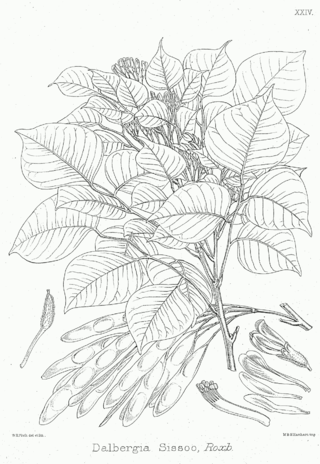
Dalbergia sissoo, known commonly as North Indian rosewood or shisham, is a fast-growing, hardy, deciduous rosewood tree native to the Indian subcontinent and southern Iran. D. sissoo is a large, crooked tree with long, leathery leaves and whitish or pink flowers.

Carya tomentosa, commonly known as mockernut hickory, mockernut, white hickory, whiteheart hickory, hognut, bullnut, is a species of tree in the walnut family Juglandaceae. The most abundant of the hickories, and common in the eastern half of the United States, it is long lived, sometimes reaching the age of 500 years. A straight-growing hickory, a high percentage of its wood is used for products where strength, hardness, and flexibility are needed. The wood makes excellent fuel wood, as well. The leaves turn yellow in Autumn.

Salix scouleriana is a species of willow native to northwestern North America. Other names occasionally used include fire willow, Nuttall willow, mountain willow, and black willow.

Vateria indica, the white dammar, is a species of tree in the family Dipterocarpaceae. It is endemic to the Western Ghats mountains in India. It is threatened by habitat loss. It is a large canopy or emergent tree frequent in tropical wet evergreen forests of the low and mid-elevations.
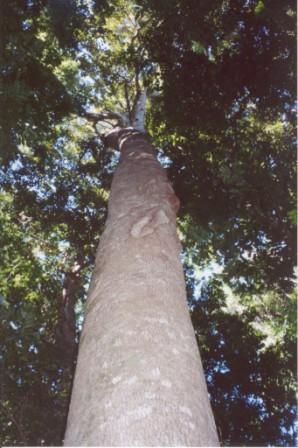
Gmelina leichhardtii, the white beech, is a tree of eastern Australia. Scattered individuals or small groups of trees naturally occur from the Illawarra district of New South Wales to near Proserpine in tropical Queensland. The white beech or grey teak is a fast-growing tree, growing on volcanic and alluvial soils in areas of moderate to high rainfall. It also grows on poorer sedimentary soils in fire free areas. White beech may occasionally be seen in Australian rainforests, though their status is considered "uncommon". Unlike the Australian red cedar, the white beech has not recovered particularly well after logging in the 19th and 20th centuries.
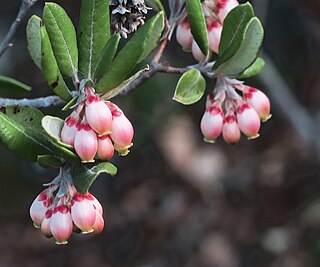
Xylococcus is a monotypic genus of flowering plants in the heather family which contains the single species Xylococcus bicolor, commonly known as the mission manzanita. It is a burl-forming, evergreen shrub with leathery leaves and smooth dark reddish bark. From December to February, white to pink urn-shaped flowers adorn the foliage, often attracting hummingbird pollinators. It is native to southern California and the Baja California Peninsula, south to the Sierra de la Giganta. There is growing concern over the future of this plant, referred to as the "queen of the elfin forest, " as it may possibly lose up to 88% of its habitat and its wild seedlings are failing to survive more than a full year.
Mitragyna rubrostipulata is a tree indigenous to East Africa. It is native from Ethiopia through east-central tropical Africa to Mozambique. It grows in wet forests up to 2,000 m above sea level and is abundant in swamp forests along Lake Victoria.
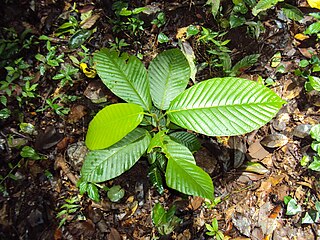
Dipterocarpus bourdillonii is a species of large tree in the family Dipterocarpaceae endemic to the Western Ghats principally in the state of Kerala in India. It is a Critically Endangered species according to the IUCN Red List of Threatened Species. It is a characteristic tree of the low-elevation tropical wet evergreen rainforests in the Western Ghats.

Bhesa indica is a flowering plant tree species in the Centroplacaceae family. It is distributed along the tropical wet evergreen forests of the Western Ghats of India. It is considered synonymous with Bhesa paniculata by some authors.
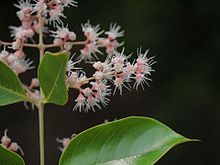



![mullcc ve[?]teekki[?]rre vitt (Lagerstroemia microcarpa germinated seedling plucked from germination medium) 01.jpg](http://upload.wikimedia.org/wikipedia/commons/thumb/8/8c/%E0%B4%AE%E0%B5%81%E0%B4%B3%E0%B4%9A%E0%B5%8D%E0%B4%9A_%E0%B4%B5%E0%B5%86%E0%B5%BA%E0%B4%A4%E0%B5%87%E0%B4%95%E0%B5%8D%E0%B4%95%E0%B4%BF%E0%B5%BB%E0%B5%8D%E0%B4%B1%E0%B5%86_%E0%B4%B5%E0%B4%BF%E0%B4%A4%E0%B5%8D%E0%B4%A4%E0%B5%8D_%28Lagerstroemia_microcarpa_germinated_seedling_plucked_from_germination_medium%29_01.jpg/67px-thumbnail.jpg)
![Lagerstroemia microcarpa seedlings - ve[?]teekki[?]rre cerriy taik[?] 6.jpg](http://upload.wikimedia.org/wikipedia/commons/thumb/0/07/Lagerstroemia_microcarpa_seedlings_-_%E0%B4%B5%E0%B5%86%E0%B5%BA%E0%B4%A4%E0%B5%87%E0%B4%95%E0%B5%8D%E0%B4%95%E0%B4%BF%E0%B5%BB%E0%B5%8D%E0%B4%B1%E0%B5%86_%E0%B4%9A%E0%B5%86%E0%B4%B1%E0%B4%BF%E0%B4%AF_%E0%B4%A4%E0%B5%88%E0%B4%95%E0%B5%BE_6.jpg/120px-Lagerstroemia_microcarpa_seedlings_-_%E0%B4%B5%E0%B5%86%E0%B5%BA%E0%B4%A4%E0%B5%87%E0%B4%95%E0%B5%8D%E0%B4%95%E0%B4%BF%E0%B5%BB%E0%B5%8D%E0%B4%B1%E0%B5%86_%E0%B4%9A%E0%B5%86%E0%B4%B1%E0%B4%BF%E0%B4%AF_%E0%B4%A4%E0%B5%88%E0%B4%95%E0%B5%BE_6.jpg)
![Lagerstroemia microcarpa seedling ve[?]teekki[?]rre tai 07.jpg](http://upload.wikimedia.org/wikipedia/commons/thumb/0/0c/Lagerstroemia_microcarpa_seedling_%E0%B4%B5%E0%B5%86%E0%B5%BA%E0%B4%A4%E0%B5%87%E0%B4%95%E0%B5%8D%E0%B4%95%E0%B4%BF%E0%B5%BB%E0%B5%8D%E0%B4%B1%E0%B5%86_%E0%B4%A4%E0%B5%88_07.jpg/67px-Lagerstroemia_microcarpa_seedling_%E0%B4%B5%E0%B5%86%E0%B5%BA%E0%B4%A4%E0%B5%87%E0%B4%95%E0%B5%8D%E0%B4%95%E0%B4%BF%E0%B5%BB%E0%B5%8D%E0%B4%B1%E0%B5%86_%E0%B4%A4%E0%B5%88_07.jpg)

















